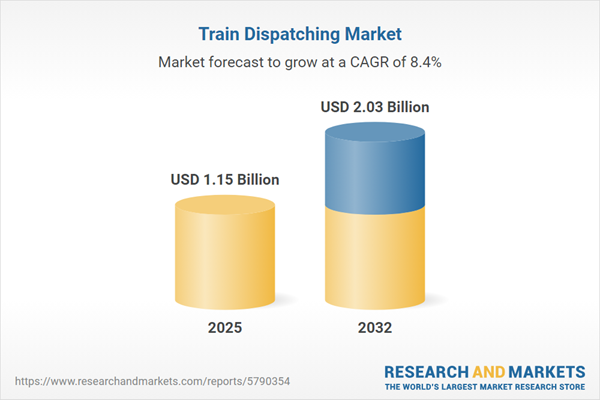Speak directly to the analyst to clarify any post sales queries you may have.
The train dispatching market is transforming rapidly as transit operators embrace digital solutions to optimize rail traffic, enhance safety, and adapt operations amid technological and regulatory change. Strategic insights into dispatching innovation, supply chain resilience, and regional drivers are vital for senior decision-makers navigating this dynamic environment.
Market Snapshot: Train Dispatching Market Overview
The global train dispatching market grew from USD 1.06 billion in 2024 to USD 1.15 billion in 2025 and is forecast to reach USD 2.03 billion by 2032. The market is showing robust growth with a compound annual growth rate (CAGR) of 8.38% over the period. Continued investment in real-time data exchange, automated scheduling, and integrated communication technologies is strengthening operational performance, safety, and reliability across freight, mass transit, and passenger rail.
Scope & Segmentation
This report delivers strategic analysis and detailed segmentation across deployment models, components, end users, and solution types. Coverage spans global regions and tiers of market players.
- Deployment Models: Cloud, Hybrid, On Premises
- Component Types: Hardware, Services (including Managed Services, Professional Services), Software
- End Users: Freight Rail, Mass Transit (covering Light Rail Transit, Metro Transit), Passenger Rail
- Solution Applications: Asset Monitoring & Diagnostics, Communication & Integration, Maintenance & Fault Management (including Fault Diagnostics, Predictive Maintenance), Route Planning (Capacity Optimization, Timetable Planning), Train Control (Automatic Train Control, Communication-Based Train Control, Positive Train Control)
- Regional Markets: Americas (United States, Canada, Mexico, Brazil, Argentina, Chile, Colombia, Peru), Europe, Middle East & Africa (United Kingdom, Germany, France, Russia, Italy, Spain, Netherlands, Sweden, Poland, Switzerland, UAE, Saudi Arabia, Qatar, Turkey, Israel, South Africa, Nigeria, Egypt, Kenya), Asia-Pacific (China, India, Japan, Australia, South Korea, Indonesia, Thailand, Malaysia, Singapore, Taiwan)
- Leading Companies: Siemens Mobility GmbH, ALSTOM SA, Thales S.A., Hitachi Rail STS S.p.A., Wabtec Corporation, China Railway Signal & Communication Corporation Limited, Construcciones y Auxiliares de Ferrocarriles S.A., Indra Sistemas S.A., Mitsubishi Electric Corporation, Toshiba Corporation
Key Takeaways for Senior Decision-Makers
- Modern train dispatching is now shaped by integration of analytics, predictive algorithms, and cloud-based platforms, moving beyond manual and rule-based models.
- Technological advances like artificial intelligence and machine learning empower real-time scheduling and detection of infrastructure anomalies, supporting continuous operational improvement.
- Regulatory mandates require interoperability and seamless integration, pushing investments in infrastructure compatibility and compliance-driven upgrades.
- Strategic partnerships between technology leaders, regional integrators, and innovative startups accelerate solution adaptation for local needs and regulatory settings.
- Regional investment priorities differ: the Americas focus on freight optimization and compliance, EMEA transitions legacy infrastructure and prioritizes safety, while Asia-Pacific invests in advanced analytics and hybrid deployments for both high-capacity passenger and freight lines.
- Complex market segmentation reflects the evolving requirements and opportunities for innovation across asset types, user profiles, and deployment strategies.
Tariff Impact on Supply Chains and Costs
Recent tariffs in the United States on signaling hardware, communication modules, and software have increased capital costs and complexity in the supply chain. Operators are revising procurement strategies, turning to local manufacturing and near-shoring of key components. These changes have also driven new sourcing models, prompting a shift toward flexible, performance-based service agreements to manage cost volatility and supply risk.
Methodology & Data Sources
This analysis is based on extensive primary interviews with rail operators, solution providers, and regulators, validated through comprehensive secondary research of white papers and industry reports. Triangulation was applied to ensure data consistency, with quality control enforced through peer review and data cross-verification.
Why This Report Matters
- Offers senior executives a framework to align digitalization investments with shifting regulatory obligations and competitive requirements in train dispatching.
- Enables informed procurement, partnership, and technology adoption decisions by evaluating segmentation relevance and current industry best practices.
Conclusion
Senior leaders can use this report to benchmark strategic moves, mitigate supply chain risks, and successfully integrate technology advances. A balanced approach across innovation, compliance, and operational priorities will be essential as rail networks evolve.
Additional Product Information:
- Purchase of this report includes 1 year online access with quarterly updates.
- This report can be updated on request. Please contact our Customer Experience team using the Ask a Question widget on our website.
Table of Contents
3. Executive Summary
4. Market Overview
7. Cumulative Impact of Artificial Intelligence 2025
Companies Mentioned
The companies profiled in this Train Dispatching market report include:- Siemens Mobility GmbH
- ALSTOM SA
- Thales S.A.
- Hitachi Rail STS S.p.A.
- Wabtec Corporation
- China Railway Signal & Communication Corporation Limited
- Construcciones y Auxiliares de Ferrocarriles, S.A.
- Indra Sistemas, S.A.
- Mitsubishi Electric Corporation
- Toshiba Corporation
Table Information
| Report Attribute | Details |
|---|---|
| No. of Pages | 194 |
| Published | October 2025 |
| Forecast Period | 2025 - 2032 |
| Estimated Market Value ( USD | $ 1.15 Billion |
| Forecasted Market Value ( USD | $ 2.03 Billion |
| Compound Annual Growth Rate | 8.3% |
| Regions Covered | Global |
| No. of Companies Mentioned | 11 |









